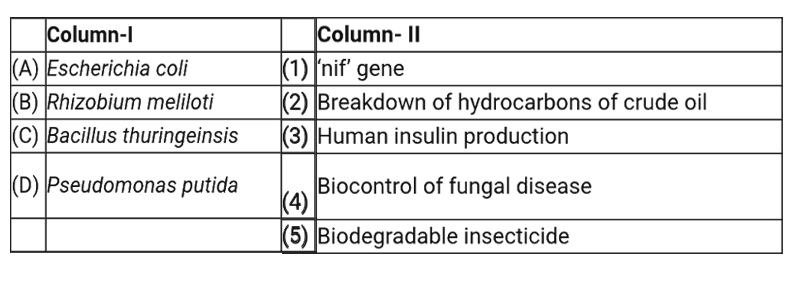Combination that do not obeys Dalton's law:
A = CO
B=Cl2
C=F2
D =Xe
A,B
B,C
B,D
A,C
The correct Answer is:C
Step by step video & image solution for Combination that do not obeys Dalton's law: A = CO B= Cl_(2) C = F_(2) D =Xe by Chemistry experts to help you in doubts & scoring excellent marks in Class 12 exams.
Similar Questions
Match the following and choose the correct combination from the options given :

(a) ABCD3154
(b) ABCD1234
(c) ABCD2134
(d) ABCD3152View SolutionGive the formulae of the stable binary compounds that wouid be formed by the combination of following pairs of elements.
(a) Mg and N2 (b)LiandO2
(c)Al and Cl2 (d) K and O2View SolutionIn the manufacture of sodium carbonate, following reactions are involved:
(A)Δ−−→(B)+CO2
(B)+H2O→(C)+NH4Cl→(D)+H2O−−−−→ESolution
(E)+CO2→(F)
(F)+NaCl→(G)Heat−−→Na2CO3+CO2+H2O
(D) is a gas which is soluble in H2O
(C ) isView SolutionIn the manufacture of sodium carbonate, following reactions are involved:
(A)Δ−−→(B)+CO2
(B)+H2O→(C)+NH4Cl→(D)+H2O−−−−→ESolution
(E)+CO2→(F)
(F)+NaCl→(G)Heat−−→Na2CO3+CO2+H2O
(D) is a gas which is soluble in H2O
(E ) and (F) areView SolutionThe rate law for reaction A+2B⇔C+2D will be :
View SolutionIn the manufacture of sodium carbonate, following reactions are involved:
(A)Δ−−→(B)+CO2
(B)+H2O→(C)+NH4Cl→(D)+H2O−−−−→ESolution
(E)+CO2→(F)
(F)+NaCl→(G)Heat−−→Na2CO3+CO2+H2O
(D) is a gas which is soluble in H2O
(B) isView SolutionIn the manufacture of sodium carbonate, following reactions are involved:
(A)Δ−−→(B)+CO2
(B)+H2O→(C)+NH4Cl→(D)+H2O−−−−→ESolution
(E)+CO2→(F)
(F)+NaCl→(G)Heat−−→Na2CO3+CO2+H2O
(D) is a gas which is soluble in H2O
(A) isView SolutionIn the manufacture of sodium carbonate, following reactions are involved:
(A)Δ−−→(B)+CO2
(B)+H2O→(C)+NH4Cl→(D)+H2O−−−−→ESolution
(E)+CO2→(F)
(F)+NaCl→(G)Heat−−→Na2CO3+CO2+H2O
(D) is a gas which is soluble in H2O
The name of the process isView SolutionIn figure, O is a point in the interior of a triangle ABC, OD⊥BC,OE⊥ACand OF⊥AB. Show that
(i) OA2+OB2+OC2−OD2−OE2−OF2=AF2+BD2+CE2
(ii) AF2+BD2+CE2=AE2+CD2+BF2
 View Solution
View SolutionAt 193∘C , the rate law for the reaction 2Cl2O→2Cl2+O2 is rate =k[Cl2O]2 .
(a) How the rate changes if [Cl2O] is raised to threefold of the original ?
(b) How should [Cl2O] be changed in order to order to double the rate ?View Solution

